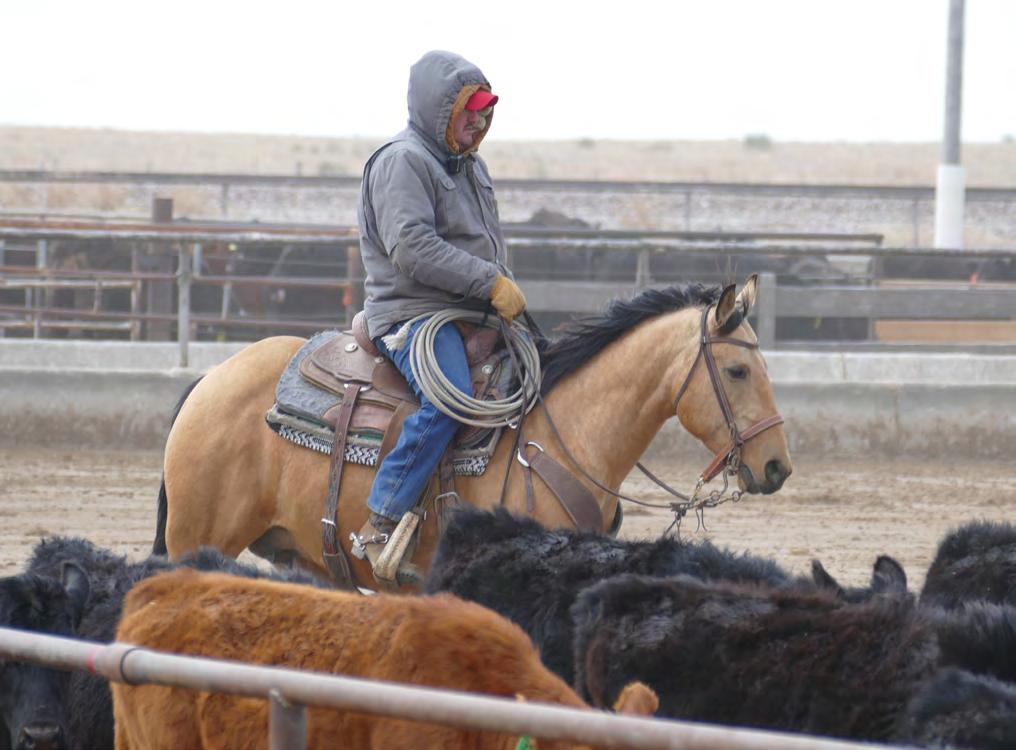
5 minute read
Creating Trust: A Key Element in Effective Cattle Handling
By Dr. Tom Noffsinger, DVM, Production Animal Consultation
In the demanding world of ranching, where every decision can impact the health and productivity of your herd, mastering the art of stockmanship is more important than ever. Stockmanship at its core is about understanding and managing cattle behavior to promote a safe and efficient working environment. Ranchers know effective stockmanship is not just a set of techniques; it is a philosophy that prioritizes animal welfare and operational efficiency.
Good stockmanship can significantly reduce stress in cattle, leading to healthier animals and, ultimately, a more profitable operation. By building trust and using calm, controlled movements, ranchers can guide their cattle with minimal resistance, reducing the risk of injury to both animals and handlers. This trust-based approach not only enhances cattle well-being but also streamlines the daily tasks of sorting, moving, and handling livestock.
To delve deeper into the essential aspects of stockmanship, one must focus on position, distance, angle, speed, and most importantly, creating trust between you and your cattle.
When cattle first arrive at your feed yard, they are often anxious and disoriented. It is our job to guide them and make them feel at home. Establishing trust from the get-go is crucial. Trust reduces their anxiety, lowers cortisol release, and improves immune function, helping them acclimate faster to their new environment. This, in turn, promotes better health and productivity.
Proper handler position is complex and requires an appreciation of cattle’s visual fields. Cattle’s sense of hearing, smell, and tactile all contribute to communication with the handler. This dynamic concept changes constantly as cattle become more familiar with our position and presence in the pen.
Good stockmen are always mindful of the space between you and the cattle. Too close, and they might feel threatened; too far, and they might not respond. Finding the right balance ensures they feel safe yet guided. Approach cattle at an angle where they can see you without feeling cornered. Cattle prefer to see their source of guidance and their destination simultaneously. They instinctively move in a half-circle around the handler, so position yourself where they can do this comfortably.
It is important to move at a steady, calm pace. Quick, sudden movements can startle cattle, increasing their stress levels. Consistent and deliberate actions help build their confidence in you as a handler. Also, avoid standing still. Consistent and deliberate movements are instrumental in building trust and improving handling efficiency.
When greeting new cattle off a truck, it is essential to make your presence known in a non-threatening way. Stand where they can see you and slowly guide them towards the holding pen. Remember, cattle follow each other, so guide the leaders, and the rest will follow. In the holding pen, ensure they have access to water and feed. Walk through the pen and let them get used to your presence. This is not just about moving them from one place to another; it is about building a relationship where they associate you with safety and resources.
When it is time to move cattle, whether to the processing barn or their home pen, always work from the front of the herd. Cattle prefer to follow a leader rather than being pushed from behind. Use small groups and guide the first few animals; they will lead the rest. Practice the rule of using two head to take ten head. This also relates to the processing barn as small drafts of cattle work best through the system. Bringing up too many cattle at once to the crowding facility at processing can lead to confusion and stress. Stockmen must guide cattle calmly and ensure that cattle can see a clear path forward. It is important to always be visible to cattle. Once the cattle start moving in the right direction, reduce the pressure and let them follow the flow.
After processing, pen riding in the first two weeks is critical to acclimating cattle. Pen riding is more than just checking on the cattle; it is about reinforcing the trust you have built. Create counterclockwise cattle motion initially with the cattle in the pen, then mix it up to ensure they are comfortable seeing you from all angles. Observe their behavior closely as happy, confident cattle will eat, drink, and rest better.
Effective cattle handling is an art that requires patience, understanding, and consistency. By focusing on distance, angle, speed, and building trust, you can significantly improve the well-being and productivity of your herd. Remember, the goal is to create a calm, stress-free environment where cattle can thrive.
Thank you to those that have dedicated their lives to improving cattle care. Your efforts make a world of difference in our industry. Keep up the great work, and let’s continue to enhance cattle handling practices together.
Dr. Tom Noffsinger is a founding partner of Production Animal Consultation and an expert in low-stress animal handling and staff development. He received his DVM from Colorado State University and completed the Beef Production Management Series at the Great Plains Veterinary Education Center. He is a member of American Association of Bovine Practitioners, Academy of Veterinary Consultants, American Veterinary Medical Association, and Nebraska Veterinary Medical Association. Dr. Tom has received multiple honors, including the 2001 AVC Consultant of the Year, the 1999 NVMA Distinguished Service Award, the 2008 AABP Merial Preventative Medicine Award for Beef, and the 2023 National BQA Educator of the Year. He and his wife Diane reside on their ranch outside beautiful Benkelman, Nebraska.










